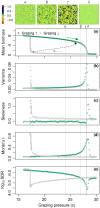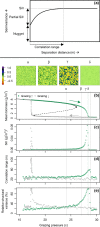Spatial early warning signals for impending regime shifts: A practical framework for application in real-world landscapes
- PMID: 30761695
- PMCID: PMC6849843
- DOI: 10.1111/gcb.14591
Spatial early warning signals for impending regime shifts: A practical framework for application in real-world landscapes
Abstract
Prediction of ecosystem response to global environmental change is a pressing scientific challenge of major societal relevance. Many ecosystems display nonlinear responses to environmental change, and may even undergo practically irreversible 'regime shifts' that initiate ecosystem collapse. Recently, early warning signals based on spatiotemporal metrics have been proposed for the identification of impending regime shifts. The rapidly increasing availability of remotely sensed data provides excellent opportunities to apply such model-based spatial early warning signals in the real world, to assess ecosystem resilience and identify impending regime shifts induced by global change. Such information would allow land-managers and policy makers to interfere and avoid catastrophic shifts, but also to induce regime shifts that move ecosystems to a desired state. Here, we show that the application of spatial early warning signals in real-world landscapes presents unique and unexpected challenges, and may result in misleading conclusions when employed without careful consideration of the spatial data and processes at hand. We identify key practical and theoretical issues and provide guidelines for applying spatial early warning signals in heterogeneous, real-world landscapes based on literature review and examples from real-world data. Major identified issues include (1) spatial heterogeneity in real-world landscapes may enhance reversibility of regime shifts and boost landscape-level resilience to environmental change (2) ecosystem states are often difficult to define, while these definitions have great impact on spatial early warning signals and (3) spatial environmental variability and socio-economic factors may affect spatial patterns, spatial early warning signals and associated regime shift predictions. We propose a novel framework, shifting from an ecosystem perspective towards a landscape approach. The framework can be used to identify conditions under which resilience assessment with spatial remotely sensed data may be successful, to support well-informed application of spatial early warning signals, and to improve predictions of ecosystem responses to global environmental change.
Keywords: alternative stable states; critical slowing down; early warning signals; ecosystem resilience; environmental change; landscapes; regime shifts; remote sensing; spatial patterns; tipping points.
© 2019 The Authors. Global Change Biology Published by John Wiley & Sons Ltd.
Figures








Similar articles
-
Experimental evidence of spatial signatures of approaching regime shifts in macroalgal canopies.Ecology. 2018 Aug;99(8):1709-1715. doi: 10.1002/ecy.2391. Epub 2018 Jul 5. Ecology. 2018. PMID: 29797316
-
Inferring critical thresholds of ecosystem transitions from spatial data.Ecology. 2019 Jul;100(7):e02722. doi: 10.1002/ecy.2722. Epub 2019 May 3. Ecology. 2019. PMID: 31051050
-
Early warning signals of regime shifts in coupled human-environment systems.Proc Natl Acad Sci U S A. 2016 Dec 20;113(51):14560-14567. doi: 10.1073/pnas.1604978113. Epub 2016 Nov 4. Proc Natl Acad Sci U S A. 2016. PMID: 27815533 Free PMC article.
-
Ecosystem regime shifts and its application prospects to ecosystem management in cold and arid regions.Ying Yong Sheng Tai Xue Bao. 2024 Jul 18;35(7):1997-2005. doi: 10.13287/j.1001-9332.202407.002. Ying Yong Sheng Tai Xue Bao. 2024. PMID: 39233430 Review. English.
-
Indicators of transitions in biological systems.Ecol Lett. 2018 Jun;21(6):905-919. doi: 10.1111/ele.12948. Epub 2018 Mar 30. Ecol Lett. 2018. PMID: 29601665 Review.
Cited by
-
Remotely sensing potential climate change tipping points across scales.Nat Commun. 2024 Jan 6;15(1):343. doi: 10.1038/s41467-023-44609-w. Nat Commun. 2024. PMID: 38184618 Free PMC article. Review.
-
Optimal sampling of spatial patterns improves deep learning-based early warning signals of critical transitions.R Soc Open Sci. 2024 Jun 5;11(6):231767. doi: 10.1098/rsos.231767. eCollection 2024 Jun. R Soc Open Sci. 2024. PMID: 39100181 Free PMC article.
-
The hidden order of Turing patterns in arid and semi-arid vegetation ecosystems.Proc Natl Acad Sci U S A. 2023 Oct 17;120(42):e2306514120. doi: 10.1073/pnas.2306514120. Epub 2023 Oct 10. Proc Natl Acad Sci U S A. 2023. PMID: 37816060 Free PMC article.
-
Tracking spatial regimes as an early warning for a species of conservation concern.Ecol Appl. 2022 Jan;32(1):e02480. doi: 10.1002/eap.2480. Epub 2021 Nov 23. Ecol Appl. 2022. PMID: 34674399 Free PMC article.
-
Evaluation of early warning signals for soil erosion using remote sensing indices in northeastern Iran.Sci Rep. 2025 Mar 21;15(1):9742. doi: 10.1038/s41598-025-94926-x. Sci Rep. 2025. PMID: 40119127 Free PMC article.
References
-
- Baartman, J. E. , Temme, A. J. , & Saco, P. M. (2018). The effect of landform variation on vegetation patterning and related sediment dynamics. Earth Surface Processes and Landforms, 43, 2121–2135. 10.1002/esp.4377 - DOI
-
- Barbier, N. , Couteron, P. , Lejoly, J. , Deblauwe, V. , & Lejeune, O. (2006). Self‐organized vegetation patterning as a fingerprint of climate and human impact on semi‐arid ecosystems. Journal of Ecology, 94(3), 537–547.
Publication types
MeSH terms
LinkOut - more resources
Full Text Sources

